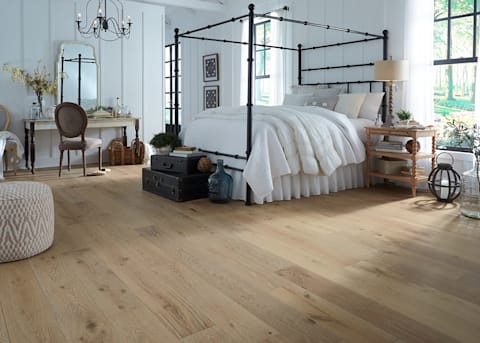- Home
- Education
- Flooring Basics
- Hardwood Flooring Noise, Soundproofing & Sound Test Ratings: STC, FSTC,IIC, FIIC
Hardwood Flooring Noise, Soundproofing & Sound Test Ratings: STC, FSTC,IIC, FIIC
What are STC, FSTC,IIC, FIIC Sound Ratings? What do they mean?
Are hardwood floors loud? No, hardwood and other solid floors are not too loud when the right products, materials, and installation methods are used. You don't have to stick with carpet. Noise can be reduced with the correct underlayment, installation, and of course rugs can take it even further.
LL Flooring experts can help choose the ideal underlayment that can impart sound control properties depending on your specific flooring goals. The advantage of some of these underlayments or pads is that they also improve comfort underfoot, can save energy costs by enhancing insulation, and help to conceal minor imperfections in your subfloor prior to installation. To ask an expert just visit or call your nearest LL Flooring Store.
Sound insulation products like underlayments are typically specified for residences, apartments, condominiums, hotels, and any customers desiring quieter floors.
Sound control materials used for impact sound insulation are engineered to absorb sound generated by footsteps, dropped objects etc. at the floor surface. Sound control standards were developed to regulate the amount of noise allowed to penetrate through common walls and floors within dwellings, and are used to compare product qualities. Under the current Sound rating system, the higher the number the better sound suppression quality.
Condo / Apartment Associations and Municipalities typically have their own standards which need to be adhered to. Check with your association for a detailed breakdown of the requirements for your home. These can be compared with the properties of the underlayments you are considering to make sire they are a good fit. In some instances, the association / municipality may have an inspection process. Ensure you perform your due diligence before proceeding with a new flooring option.
(IIC) Impact Insulation Class *ASTM E492/E989 and (STC) Sound Transmission Class ASTM E336/E413 are both tests for sound traveling through the total floor/ceiling assembly from an upper living area to a lower living area.
IIC testing is for impact noise, like footfalls, moving furniture, things dropping on the floor, etc. STC is for airborne sound like voices or music. IIC and STC tests are conducted in sound test laboratories.
It is important to understand that IIC and STC tests are not for individual components of a flooring assembly, but for the whole floor/ceiling structure, from the surface of the floor covering material in the upper unit all the way to the ceiling in the unit below. Each IIC or STC test report issued has a detailed description of the floor/ ceiling assembly used in that test. For engineered wood flooring installations, the results depend on the type of materials used in the construction of the building, along with the underlayment selected for the application.
(FIIC and FSTC) ASTM E1007 and E989 are Field tests performed by setting up test equipment in a building. The International Building Code suggests a rating of 50 or more for IIC and STC, but allows 45 or more for FIIC or FIIC field tests.
(IIC) Impact Insulation Class, (FIIC) Field Impact Insulation Class, (STC) Sound Transmission Class and (FSTC) Field Sound Transmission Class sound testing procedures are all included in the International Building Code as official test methods for sound evaluation.
There is one more type of sound that may be discussed in relation to flooring material: the sound that reverberates or echoes within the room where the floor is installed. While resonating sound is obviously important to the consumer, the ability to obtain quantitative measurements has been difficult and elusive. As of yet, there is no ASTM or ANSI method established for the evaluation of resonating sound and the International Building Code does not recognize resonating sound testing.
Please SUBSCRIBE to the LL Flooring YouTube Channel to learn more, ask questions, leave comments that helped you, and join the community!
Order 4 free samples of flooring (no credit card needed) at:
https://www.llflooring.com/
Shop all SALE flooring including waterproof vinyl plank, laminate, hardwood, tile and more, at:
https://www.llflooring.com/c/sale/
VISIT the flooring store closest to you:
https://www.llflooring.com/stores/
Are you exploring what might help achieve the optimal sound control with your new floors?
This video will discuss underlayments, a valuable part of the home and any new flooring. Even if you choose a floor with pre-attached padding, the addition a quality underlayment can elevate the sound, feel, and performance of that floor for a premiere experience you'll be thankful for.
Please SUBSCRIBE to the LL Flooring YouTube Channel to learn more, ask questions, leave comments, and join the community!





